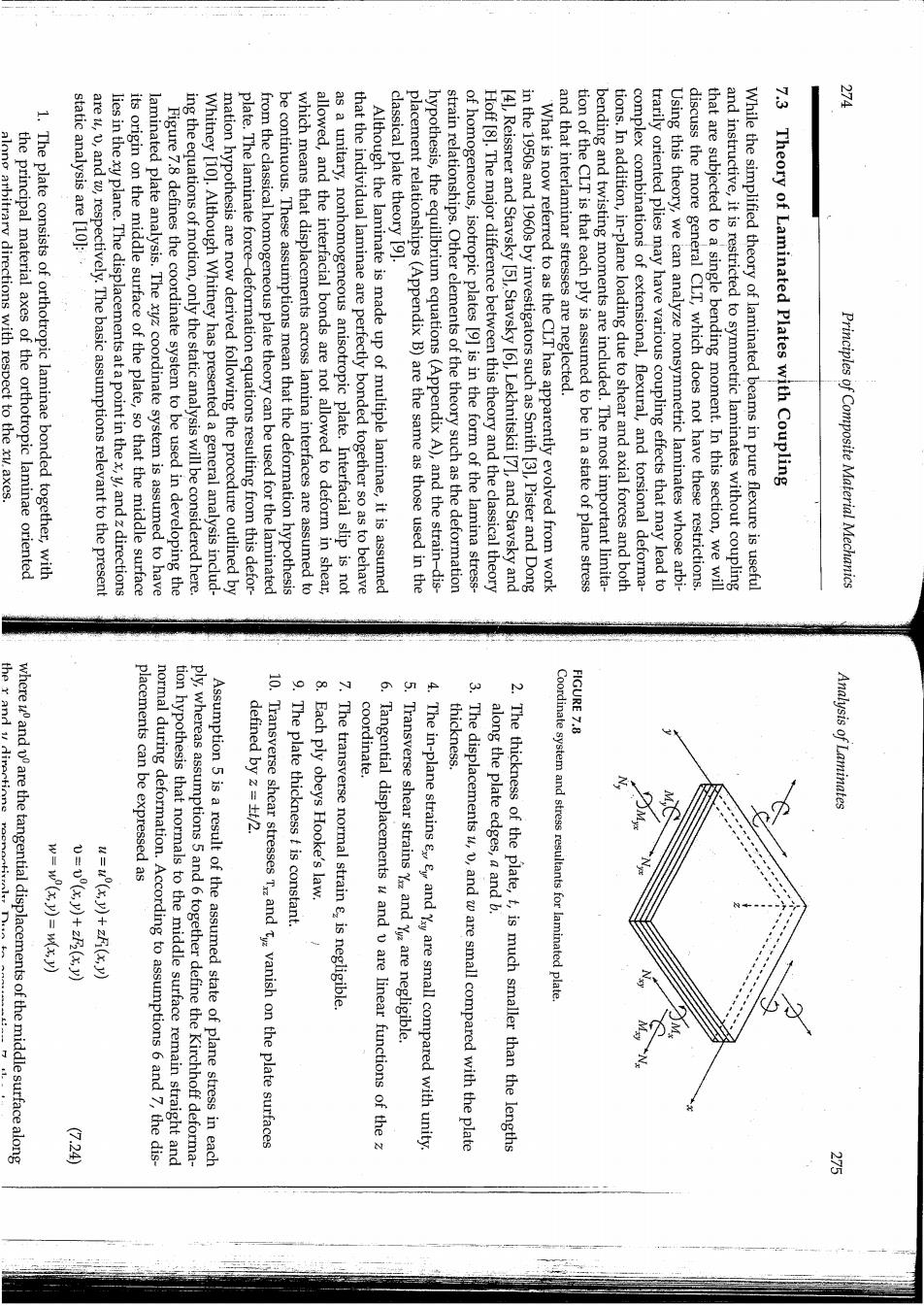正在加载图片...

出 along arbitrary directions with respect to the xu axes. the principal material axes of the orthotropic laminae oriented 1.The plate consists of orthotropic laminae bonded together,with static analysis are [10]: are u,v,and w,respectively.The basic assumptions relevant to the present lies in the xy plane.The displacements at a point in thex,y,and z directions its origin on the middle surface of the plate,so that the middle surface laminated plate analysis.The xyz coordinate system is assumed to have Figure 7.8 defines the coordinate system to be used in developing the ing the equations of motion,only the static analysis will be considered here. Whitney [10].Although Whitney has presented a general analysis includ- mation hypothesis are now derived following the procedure outlined by plate.The laminate force-deformation equations resulting from this defor- from the classical homogeneous plate theory can be used for the laminated be continuous.These assumptions mean that the deformation hypothesis which means that displacements across lamina interfaces are assumed to allowed,and the interfacial bonds are not allowed to deform in shear, as a unitary,nonhomogeneous anisotropic plate.Interfacial slip is not that the individual laminae are perfectly bonded together so as to behave Although the laminate is made up of multiple laminae,it is assumed classical plate theory [9]. placement relationships(Appendix B)are the same as those used in the hypothesis,the equilibrium equations(Appendix A),and the strain-dis- strain relationships.Other elements of the theory such as the deformation of homogeneous,isotropic plates [9]is in the form of the lamina stress- Hoff [8].The major difference between this theory and the classical theory [41,Reissner and Stavsky [5],Stavsky [6],Lekhnitskii [7],and Stavsky and in the 1950s and 1960s by investigators such as Smith [31,Pister and Dong What is now referred to as the CLT has apparently evolved from work and that interlaminar stresses are neglected. tion of the CLT is that each ply is assumed to be in a state of plane stress bending and twisting moments are included.The most important limita- tions.In addition,in-plane loading due to shear and axial forces and both complex combinations of extensional,flexural,and torsional deforma- trarily oriented plies may have various coupling effects that may lead to Using this theory,we can analyze nonsymmetric laminates whose arbi- discuss the more general CLT,which does not have these restrictions. that are subjected to a single bending moment.In this section,we will and instructive,it is restricted to symmetric laminates without coupling While the simplified theory of laminated beams in pure flexure is useful Theory of Laminated Plates with Coupling Principles of Composite Material Mechanics the r and v dirertions placements can be expressed as thickness. FIGURE 7.8 where uand are the tangential displacements of the middle surface along normal during deformation.According to assumptions 6 and 7,the dis- coordinate. tion hypothesis that normals to the middle surface remain straight and ply,whereas assumptions 5 and 6 together define the Kirchhoff deforma- Assumption 5 is a result of the assumed state of plane stress in each 10.Transverse shear stresses Tand ty vanish on the plate surfaces defined by z=t/2. 9.The plate thickness t is constant. 8.Each ply obeys Hooke's law. The transverse normal strain e,is negligible. Tangential displacements u and v are linear functions of the 5.Transverse shear strains Y and Y are negligible. 4.The in-plane strains ey and Ysy are small compared with unity. The displacements u,v,and w are small compared with the plate along the plate edges,a and b. 2.The thickness of the plate,t,is much smaller than the lengths Coordinate system and stress resultants for laminated plate Analysis of Laminates (7.24)